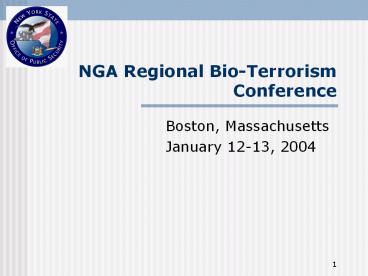NGA Regional Bio-Terrorism Conference - PowerPoint PPT Presentation
1 / 13
Title:
NGA Regional Bio-Terrorism Conference
Description:
... Agro-terrorism / Food security Chemical Industry Fraudulent Documents Cyber-Terrorism How ... Aviation Weapons of Mass Destruction Conventional ... – PowerPoint PPT presentation
Number of Views:180
Avg rating:3.0/5.0
Title: NGA Regional Bio-Terrorism Conference
1
NGA Regional Bio-Terrorism Conference
- Boston, Massachusetts
- January 12-13, 2004
2
Strengthening the Bonds Between Homeland Security
and Public Health
- George Estel
- Health Policy Advisor
- New York State Office of Public Security
3
Office of Public Security
- Established by Governor Patakis Executive Order
on October 10, 2001 - Mission Develop and Direct a Comprehensive
Statewide Strategy to Counter Acts of Terrorism
in New York - Coordinate the Federal Department of Homeland
Security, State and Local Agencies on
Counter-Terrorism Issues - Enable New York State to Prevent, Respond to and
Recover from Acts of Terrorism
4
OPS Operating Divisions
- Intelligence / Analysis
- Operations
- Legal
- Information Technology
5
New York States Counter-Terrorism Zones
6
What are the current major threats?
- General Aviation
- Weapons of Mass Destruction
- Conventional Explosives
- Agro-terrorism / Food security
- Chemical Industry
- Fraudulent Documents
- Cyber-Terrorism
7
How prepared are we?
- To detect and deter
- Increased collaboration on prevention strategies
- Enhanced information sharing within the law
enforcement community and our non-law enforcement
public and private partners - To respond and recover
- Focused planning and readiness efforts on RBC and
other mass casualty events - Enhanced first responder capability through new
equipment, training and exercises.
8
Detect and Deter
- Remains primary focus of OPS
- Built on collaboration and information sharing
- Bi-weekly security meetings
- 22 State Agencies and Authorities
- Task Force Development for specific issues
- CBERN
- Training and Exercises
- Food / Animal Security
- Fraudulent Document
- Public Security Advisory Dissemination
- Counter-Terrorism Network
- Information Sharing Analysis Centers
- State Agency Secure Websites (i.e. PHAN)
- Private Sector Secure Websites (GNYHA)
9
Respond and Recover
- Revising Comprehensive State Emergency Management
Plan to Include Terrorism - Functional Annexes (i.e. Law Enforcement /
Security) - Individual Agency planning (i.e. Public Health)
- Training and Exercises
- WMD funded exercise and evaluation program
- CDC funded Public Health exercises
- National Response Plan
- National Incident Management System
- Incident Command System
10
Existing Levels of Coordination
- For Prevention
- OPS facilitated collaborative efforts have
promoted greater partnership and information
sharing. - Between and among Federal, State and local law
enforcement officials - Between law enforcement community and other state
agency or authority assets with law enforcement
responsibility (Environmental Conservation, Port
Authority, Mass Transit Authority, Division of
Military and Naval Affairs) - Non-law enforcement public and private partners
- Has proved particularly effective when changes
occur in the nations Threat Alert Status - Northeast Regional Homeland Security Directors
Consortium (Maine to Delaware, Ont. Que. N.Brun.)
11
Existing Levels of Coordination
- For Response and Recovery
- Various task forces have helped focus and
coordinate multi-agency efforts - Chemical and radiological concerns
- Bio-terrorism planning efforts are proceeding
along quite effectively - Hospital preparedness efforts have also improved
markedly - First responder training needs (300,000
traditional professionals) - Exercise and evaluation process in the beginning
phase of implementation - Previous threat alert status changes have
tested response
12
Unmet levels of coordination
- Multi-stage response around shared metropolitan
areas. - Should we consider a plan similar to the one for
the National Capital Region - Private sector activities
- Partnering in prevention
- Resource for emergency response activities
- Federal response action in the event of a
terrorist incident - TOPOFF exercises
- Implementing NIMS
- Federal Readiness standards under development
13
Obstacles / Challenges to Preparedness
- Stove piping of effort
- DHS policy on WMD funding dispersal to localities
- NIMS development and implementation
- Integration of prevention efforts into normal
work activity - Need to rebuild emergency management
infrastructure - Public complacency































